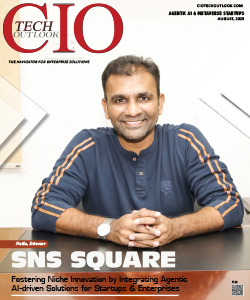Why is it Crucial to Evaluate Skills for UX UI Designer
CIOReviewIndia Team | Tuesday, 27 October 2020, 09:36 IST
 User Experience and User Interface is a blooming field in today’s market. According to the research, these two domains have vast growth and job opportunities worldwide. To pursue a career in this domain requires the right training and skills to meet rising business demands. Hence the need for evaluating the skills. It also becomes essential to gain expertise through the UX UI designer course.
User Experience and User Interface is a blooming field in today’s market. According to the research, these two domains have vast growth and job opportunities worldwide. To pursue a career in this domain requires the right training and skills to meet rising business demands. Hence the need for evaluating the skills. It also becomes essential to gain expertise through the UX UI designer course.
Demand for UI UX
The fight for our attention is greater than ever as rich digital content vies for millions of eyeballs. With major distractions around, it is on high chances of reaching a “peak cognitive crisis.” Images, videos, text, illustrations, animations, and podcasts overload our senses with sponsored posts, fake news, our friends’ vacation photos, social media news, and hype around it, all in the span of fewer than 10 seconds as we scroll through a social network feed.
The concept of User Experience (UX) is related to the tactical aspect of UX. Researching components and designing is from a user-centric perspective at the interface level.
The popularity is so tremendous that almost everyone sitting in every corner of the world uses websites and applications. Due to this high demand for UX, there are immense job opportunities worldwide. This paves a way to learn the emerging techniques of a UX UI design to get into the domain and choose your career.
Why is it crucial to evaluate skills?
The main motto of an organization is to increase its sales/revenue and the organization’s growth. UX UI Design plays an essential role in achieving this goal. How?
- The UX UI Design of the application improves the user experience and user satisfaction that directly helps increase the number of users of the specific application.
- The UI and UX Design help you attract customers and make them use your application or website by offering them what they are looking for. The traffic on the website or application measures the success rate of the UI and UX. UX and UI are key to maintain the brand of your organization.
So what if UX and UI go wrong? There are chances that users might not like using the application. There is a high possibility of business loss as the number of sales will dip down and affects the business revenue and growth.
Due to these factors, it becomes crucial for the organizations and employers to evaluate the skills before hiring a UX UI designer. The one with the right skill-set is an asset to the organization and helps in business growth.
In this article, we’ll discuss the most important skills of a UX UI designer. These skills can be acquired with various sources, but taking up the UX UI designer course would be a suitable choice.
UX Research
UX research also called design research, identifies and proves the assumptions, finds commonalities across the target audience members. It also recognizes the needs, goals, and mental models.
It focuses on understanding user behaviors, needs, and motivations through observation techniques, task analysis, and other feedback methodologies.
UX practitioners have studied and incorporated many techniques from academics, scientists, market researchers, and others. However, there are numerous types of research that are unique to the UX world.
The main motto of UX research is to develop and notify the design process from the end-users perspective. One of the other advantages of user research is that it helps us understand how people live their lives so that we can respond to their needs with informed design solutions. Better UX research involves using the right method at the right time during the development of a product.
UX Research Types
UX researcher is a mix of quantitative and qualitative research. Quantitative research is measurable, while qualitative is not.
- Quantitative research can be measured numerically. It answers questions such as “how many users visited the home page”? It understands statistical likelihoods and what is happening on a site or in an app.
- Qualitative research is also known as “soft” research, and answers questions like “determining why 1000 people abandoned at checkout” and also takes the form of interviews or conversations. Qualitative research helps understand why people do the things they do.
UX research techniques also follow one of three below-mentioned key methodologies:
- Observation: UX researchers observe people interacting with a product and look for behavioural clues to understand what a person thinks of a product. Do they find it easy to use? How was the behaviour reflecting based on the product?
- Understanding: UX researchers try to understand consumers’ “mental model.” According to Nielsen Norman Group, a mental model is “what users know (or think they know) about a system such as your website.” When a person visits a webpage, they act according to their mental model. If they click the magnifying glass icon, they expect it to open a new search; if they click on your logo, they expect it to direct them back to the homepage, and so on. Thus, a product’s design must be well aligned with a consumer’s mental model.
- Analysis: UX researchers must not only be able to observe and understand consumer behaviour, but they must also be able to interpret it as well. They need to analyze their findings to identify patterns and trends that they can then share with the UX design team in a digestible way.
Collaboration
Collaboration simply means working with teams. It all deals with how to code, manage projects, design, understand the product, and market by collaborating with experts. The key task is to collaborate with others in the design process to become successful in the field.
Research can only take you so far. But collaborating is the chance to work in other areas and apply the knowledge with different people whose skills complement your own.
Collaboration is an important UX designer skill as it lets you communicate with clients and stakeholders more efficiently to ensure the resulting product meets both business goals and user expectations. It is favourable not only for design deliverables like wireframes, prototypes, and comps, but also for user-research deliverables, such as reports, presentations, and data analyses.
Wireframing and Prototyping
The art of convincing people of your UX acumen lies in wireframing and prototyping.
A wireframe is a low-fidelity representation of your product. In the world of web and mobile design, it is a basic guideline of your website or app – the skeletal framework – for both designers and developers to follow.
However, you’re likely to get a different answer on what a wireframe is, based on whom you approach – designers vs. developers.
For example, developers use wireframes to understand the core functionality of a website or app. On the other hand, designers use them to demonstrate the navigation flow between site screens.
App prototyping is about understanding the main functionality of the design before being built by developers. Prototyping tools allow you to test the assumptions from the user research. It also lets you validate with subsequent user testing. Hence, this skill is a great way to get buy-in from stakeholders and managers.
UX Writing
Writing is the detailing of many tasks and the feasible mode to convey things in the long run. So is the case with UX. Many of us focus more on coding, which is a skill that shouldn’t be ignored, but writing is a talent that can be nurtured over less time to create brilliant user experiences. Just take a look at any popular apps, and it will be filled with perfectly crafted words. It is all due to UX writing.
UX writers write the copy found throughout a digital product. It includes the text on menus, buttons, error messages, and more. This is referred to as microcopy. In a more generic way, UX writers are tasked with delivering the messaging of the product from the inside out. In order to do this in an efficient manner, one must acquire a deep understanding of the user and often conduct UX research. This can be achieved either through experience and practice or can go for a UX UI designer course.
Visual Communication
Visualization and communication are the two key factors of any task. Visualizing the design and communicating with the clients or stakeholders is the main task of UX. It involves various tasks, as listed below.
Tasks
It includes everything within the visual and communication industry. For example – video filming and editing, photography, graphic design, website design, drawing and illustrating, animation, working with clients, layout and the list goes on.
Perspective
The perspective of a visual communication designer is a broader one. As you can see from the above tasks, it covers almost all the design perspectives. Which implies the perspective would be of the whole, rather than one specific part. It is almost like an Art Director or a Brand Manager.
Final Thoughts
UX is a fast-growing and lucrative field. The main focus of a UX UI designer is on the customers’ wants and needs.
Observation, understanding, and analysis are the three key methodologies employed by UX designers, and it is necessary to opt for these skills to master the career.
A UX designer should have a solid understanding of analytics and the design process as a whole. Still, they also need soft skills such as adaptability, understanding of human behaviours, and a willingness to collaborate.
The skills mentioned above like wireframing, prototyping, UX writing is the best way to break into the field is to immerse yourself in it. Read as much as you can on the topic, network with people in the field, and either shadow or volunteer on projects to build a portfolio that you can later present to prospective employers. Also, take up theUX UI designer course to know the Knitty gritty techniques of the UX. This also helps the employers to evaluate the skills with much ease.
Ready to further develop your UX design skills? Springboard’s UX Career Track is a self-paced, mentor-guided Bootcamp focusing on helping you land your dream job in user experience.




